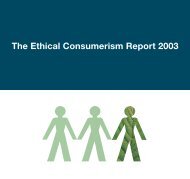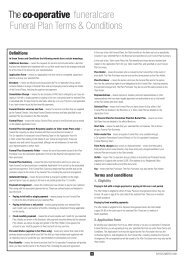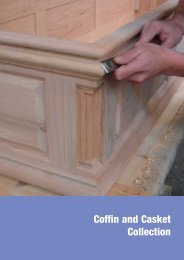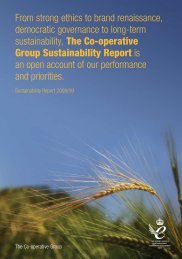Download a printable Great Eggcase Hunt guide ... - The Co-operative
Download a printable Great Eggcase Hunt guide ... - The Co-operative
Download a printable Great Eggcase Hunt guide ... - The Co-operative
You also want an ePaper? Increase the reach of your titles
YUMPU automatically turns print PDFs into web optimized ePapers that Google loves.
Join the <strong>Great</strong> eGGcase hunt<br />
What does a mermaid<br />
keep in her purse?<br />
Baby sharks, skates and rays of course!<br />
With over 600 species of skate and ray worldwide, at least 15 species are<br />
regularly encountered in UK coastal waters, many of which reproduce by<br />
laying tough, leathery eggcases known as ‘mermaid’s purses’. <strong>The</strong> eggcases of<br />
approximately eight skate and ray and two shark species are commonly found<br />
along the strandlines of UK beaches.<br />
Each species lay eggcases in different<br />
shapes and sizes, which remain on<br />
the seabed or attached to seaweed<br />
for several months while the embryo<br />
inside develops into a miniature<br />
skate, ray or shark. Once empty, the<br />
eggcases are often washed ashore<br />
and can be found amongst the<br />
seaweed in the strandline.<br />
Be safe on the beach:<br />
Wear appropriate clothing and footwear;<br />
Go with an adult or tell someone where you’re going;<br />
Be aware of the tide times;<br />
Why report eggcases?<br />
<strong>The</strong> distribution of different shark, skate and ray<br />
species is changing and a number of species are in<br />
decline. By taking part in the <strong>Great</strong> <strong>Eggcase</strong> <strong>Hunt</strong> you<br />
are helping the Shark Trust to identify areas of the<br />
coast where eggcases regularly wash up. <strong>Eggcase</strong>s may<br />
indicate that nursery grounds are nearby and identifying<br />
these grounds can assist in the conservation of sharks,<br />
skates and rays. Your eggcase records are a crucial<br />
element of this conservation work.<br />
Use a stick or your boot to search through seaweed;<br />
Always respect wildlife and the seashore code by<br />
not removing live plants or creatures from the beach.<br />
Image © Rachel <strong>Co</strong>ppock<br />
How to hunt…<br />
<strong>Eggcase</strong>s can be found on the beach all year round,<br />
so always keep your eyes open!<br />
<strong>The</strong> Chance Find Whenever you are out on the beach, keep a look-out for<br />
eggcases. If you come across one, fantastic! Report it to us so we can add your find<br />
to our database.<br />
Simple Science Set out a timed walk of a set distance.<br />
Beach Survey Walk the length of the beach along the lower strandline and then<br />
return along the higher strandline, recording as you go.<br />
finish time<br />
lower strandline<br />
Undulate Ray (Raja undulata) Vs.<br />
Spotted Ray (Raja montagui)<br />
upper strandline<br />
start time<br />
Before you leave the beach, remember to record the location, date and take<br />
photographs if you aren’t taking the eggcases home with you.<br />
Bucket Science<br />
Fill a container with water and leave<br />
the eggcase to soak for a few hours<br />
(larger eggcases will need to soak<br />
for longer to fully hydrate). Once the<br />
eggcase is ready, use the Shark Trust<br />
ID <strong>guide</strong> to identify it.<br />
How to report your findings<br />
Visit www.eggcase.org<br />
Submit an online recording form.<br />
Attach photographs of the eggcases<br />
against a scale (such as a tape<br />
measure or 2p coin) so we can verify<br />
your records. If you are in any doubt<br />
about your species or think you may<br />
have found an interesting one then<br />
please post it to us so we can have a<br />
closer look.<br />
<strong>The</strong> Shark Trust is the conservation charity dedicated to the study, management and conservation of sharks, skates and rays.<br />
www.greenschools.coop<br />
www.eggcase.org<br />
Project also funded by:<br />
All images other than indicated © <strong>The</strong> Shark Trust, beach illustration by Marc Dando © <strong>The</strong> Shark Trust.
thE GrEat EGGcasE hunt<br />
2<br />
<strong>The</strong> young inside<br />
the egg will<br />
develop, sometimes<br />
for over a year but<br />
this depends on<br />
species.<br />
3<br />
A tiny split opens along<br />
the top of the eggcase and<br />
the young skate wriggles<br />
free as a miniature version<br />
of the adults.<br />
<strong>Eggcase</strong>s are made from<br />
collagen and keratin, which<br />
are the same substances<br />
that human hair and<br />
fingernails are made from.<br />
skate Life cycle<br />
<strong>The</strong> process of laying<br />
eggs that hatch<br />
outside the female is<br />
known as oviparity.<br />
www.greenschools.coop<br />
4<br />
<strong>The</strong> young skate will<br />
continue to grow.<br />
5<br />
When old enough,<br />
the now adult skate<br />
will produce her own<br />
eggs and the process is<br />
repeated.<br />
1<br />
Eggs are laid by the female<br />
skate on the seabed.<br />
6<br />
Empty eggcases are<br />
picked up by currents and<br />
carried inshore.<br />
Once empty, eggcases are known as<br />
mermaid’s purses.<br />
You can find eggcases along UK beaches<br />
and use the identification <strong>guide</strong> to work<br />
out what species they come from.<br />
Send your findings to the Shark Trust’s<br />
<strong>Great</strong> <strong>Eggcase</strong> <strong>Hunt</strong> for recording.<br />
www.sharktrust.org
Skate and Ray <strong>Eggcase</strong> Identification Guide<br />
This <strong>guide</strong> represents species commonly found around the UK coast. If your find is not represented in this <strong>guide</strong> visit www.eggcase.org for more details.<br />
Blonde<br />
Blonde Ray – Raja brachyura<br />
Approx. capsule length 90 mm<br />
Obvious keels.<br />
Top horns much longer than bottom horns.<br />
Similar eggcase: Thornback eggcase.<br />
Difference: Blonde eggcase is<br />
much larger.<br />
caTSHaRkS<br />
SmallSpoTTed caTSHaRk<br />
Scyliorhinus canicula<br />
Approx. length 40 mm<br />
Short, narrow capsule.<br />
If unbroken, long curly tendrils at each end.<br />
Similar eggcase: Nursehound eggcase.<br />
Difference: Smallspotted Catshark eggcase is<br />
much smaller.<br />
nuRSeHound<br />
Scyliorhinus stellaris<br />
Approx. length 90 mm<br />
Long, narrow capsule.<br />
Thick sides to capsule<br />
If unbroken, long curly tendrils<br />
at each end.<br />
Similar eggcase: Smallspotted<br />
Catshark eggcase.<br />
Difference: Nursehound eggcase<br />
is much larger.<br />
Smallspotted catshark adult<br />
Nursehound adult<br />
You may know these species<br />
as dogfish, but they are in truth<br />
catsharks, as true dogfish give<br />
birth to live young.<br />
Small-eyed<br />
Small-eyed Ray – Raja microocellata<br />
Approx. capsule length 75 mm<br />
Long filamentous horns at top.<br />
<strong>Eggcase</strong> capsule is wider at top<br />
than bottom.<br />
Obvious keels.<br />
undulaTe<br />
undulaTe Ray – Raja undulata<br />
Approx. capsule length 70 mm<br />
No keels.<br />
More commonly found in southwest of UK.<br />
Similar eggcase: Spotted eggcase.<br />
Difference: Undulate eggcase is much larger.<br />
THoRnBack<br />
THoRnBack Ray – Raja clavata<br />
Approx. capsule length 65 mm<br />
Quite ‘square’ in appearance.<br />
Obvious keels.<br />
Similar eggcase: Blonde eggcase.<br />
Difference: Thornback eggcase is much smaller.<br />
SpoTTed<br />
SpoTTed Ray – Raja montagui<br />
Approx. capsule length 60 mm<br />
No keels.<br />
Nationwide distribution around the UK.<br />
Similar eggcase: Undulate eggcase<br />
Difference: Spotted eggcase is<br />
much smaller.<br />
Similar eggcase: Cuckoo eggcase.<br />
Difference: Spotted eggcase is<br />
less rounded and has<br />
shorter top horns.<br />
STaRRy<br />
STaRRy SkaTe – Amblyraja radiata<br />
Approx. capsule length 35 mm<br />
Very small.<br />
Obvious keels.<br />
Surface of capsule textured like stiff velvet.<br />
Blonde Ray adult Small-eyed Ray adult Thornback Ray adult Starry Skate adult<br />
Soaking eggcases in water for an hour makes identification easier<br />
Funded by:<br />
EGGCASE FEAtUrES<br />
cuckoo<br />
Field<br />
Capsule<br />
Keel<br />
Field<br />
Horn<br />
cuckoo Ray – Leucoraja naevus<br />
Approx. capsule length 50 mm<br />
Small, delicate, rounded eggcase.<br />
If unbroken, very long horns at top. No keels.<br />
Similar eggcase: Spotted eggcase.<br />
Difference: Cuckoo eggcase is more rounded and<br />
has longer top horns.<br />
undulate Ray adult Spotted Ray adult cuckoo Ray adult<br />
www.sharktrust.org approximate sizes are for soaked eggcases and excluding horns www.eggcase.org

















